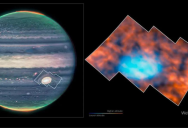New Study Details Findings Of Previously Undetected Structures In Atmosphere Above Jupiter’s Red Spot

The James Webb Space Telescope (JWST), which has only been in service since late 2021, has helped astronomers view the furthest depths of space in ways that had not been possible before.
Recently, however, scientists decided to turn the telescope’s powerful lenses toward something much closer: Jupiter.
Jupiter has been fascinating scientists for generations, and it seems that every time it is studied, they discover something new. By pointing the JWST, astronomers were able to gather a lot of information about the gas giant.
One thing of particular note that was published in a study in the journal Nature Astronomy is concerning the atmosphere just above the planet’s iconic red spot.
The lead author of the study, Henrik Melin of the University of Leicester, said in a statement about what they observed:
“We thought this region, perhaps naively, would be really boring. It is in fact just as interesting as the northern lights, if not more so. Jupiter never ceases to surprise.”
What they discovered were described as ‘dark arcs’ and ‘bright spots’ within the upper atmosphere in this area.

This was seen as a slight glowing in the region, which could be seen thanks to the Near-InfraRed Spectrograph (NIRSPEC) instruments on the telescope.
Similar instruments from Earth-based telescopes could not see them due to atmospheric interference from our planet. Having the space telescope available offers a much clearer view.
Henrick discussed these mysterious structures and how they may be created in his statement, saying:
“One way in which you can change this structure is by gravity waves — similar to waves crashing on a beach, creating ripples in the sand. These waves are generated deep in the turbulent lower atmosphere, all around the Great Red Spot, and they can travel up in altitude, changing the structure and emissions of the upper atmosphere.”
While a lot more study will be needed, the fact that something new and exciting has been found using the JWST in this way is encouraging.
Scientists will undoubtedly want to continue to use this powerful tool to look at objects closer to home.
Learning more about our space neighbors is exciting.
If you thought that was interesting, you might like to read a story that reveals Earth’s priciest precious metal isn’t gold or platinum and costs over $10,000 an ounce!

Sign up to get our BEST stories of the week straight to your inbox.




